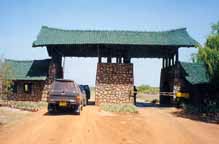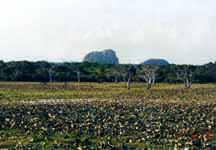
Entrance to the sanctuary
by Derrick Schokman - DN Sat Jun 21 2003
 Entrance to the sanctuary |
The Yala East National Park, closed since May 1985 because of the war in the North and East, was reopened to the public in March this year by the Wildlife Conservation Department.
This park of 148 Sq. miles is block 3 of the Ruhuna National Park. On the West is the sea with a succession of salt-water lagoons. Stretching across from the sea westwards to Galge with the Kumbukkan-oya as its southernmost border, the park is a fascinating wilderness made up of plains, scrub jungle, high forest and several rocky outcrops. Kudumbigala
The park is accessed via the Wellawaya-Pottuvil Road, continuing south past Panama to Okanda. A mile beyond Okanda on the right is Kudumbigala, a dominating rock outcrop that is now used as a Forest Hermitage. There is a partly restored stupa on the top and drop-ledge caves at the base dating back to the second century BC.
This hermitage was started by Bhikku Anandasiri in the 1950s. He considers it an ideal spot because of its remoteness and the wild animals who act as a deterrent to unwanted visitors, allowing him and his pupils to get on with their meditation. They are ably supported by Upasakas who trek there from Pottuvil 20 miles away, bringing them their supplies of food etc.
 Birdwatching |
There are plenty of other cave dwellings in the park, some of them with ruined stupas and Buddha monuments. But they are all unoccupied.
On the northern border of the park at a place called Veheragala there is an extensive area of rocky outcrops and caves. Access to this area is along a jeep track from Kumana along the Kumbukkan-Oya to Mahawelatota 16 miles from Kumana. Another five miles to the east along the park boundary will bring you to Veheragala.
There are several other such places at Kiripokunahela, Bambaragastalawa, Kongala, Diulangoda and Talaguruhela. There is also a jungle shrine to Goddess Pattini at Kebilitta.
Kumana Villu
In this park Kumana villu was a special attraction as a nursery for our indigenous water birds. It is a seasonal feature. In the dry season when a sand bar forms at the mouth of the Kumbukkan-oya, the level of water in the river rises and the surplus is carried along a channel into this Villu or mangrove swamp in which there are kirala trees and karang and hambu bushes.
That is where teal, grebe, herons, pelicans, cormorants, stork, ibis, spoonbills, purple coot and pheasant tailed jacana made their nests in the trees, bushes and even in the floating vegetation. When the Villu became overcrowded the aquatic avian population spilled over into the Kumana lake nearby.
By mid-May at the height of the breeding season these two places would sound and smell like a fish market. There was never any scarcity of food because the nearby lagoons had plenty of fish. Yet the birds would squawk and squabble while feeding their young as if there was a severe shortage.
Towards the end of July going on August the young were fully fledged and ready to leave the nests. By the time the rains came in October they were all gone.
The Kumbukkan Oya
 Sanctuary office |
The Kumbukkan Oya would then swell again and burst the sand bar. No more water comes into the Kumana Villu until the return of the dry season in the following year. The annual cycle of filling and emptying the Villu is thought to be nature's way of keeping it free of pollution that could be caused by the accumulation of bird droppings and other waste products.
There were reports after the park was closed in 1985 by adventurers who wandered into the area that the Kumana Villu was deserted. Wildlife Rangers who have served in that area have a plausible explanation. According to their observations there have been fluctuations in the number of nesting birds. There are times of heavy nesting and lean periods. No one quite knows why. May be those adventurers had visited Kumana during off times. Or may be poachers had been responsible.
Even without the star attraction of the Kumana nursery, the Yala East Park can be a birdwatchers' paradise. It is the habitat of most low country birds. Along the Kumbukkan oya bulbuls, trogans, parakeets, orioles, blue nethatches, grackel and king fishers in all their variety are plentiful.
Fly catchers are interesting birds. They are capable of putting on a fantastic aerial performance of loops, rolls and twists that look very much like drunken dancing. They have accordingly earned the name of "drunken pipers." Then there are the migrants or "bird tourists" who, like their human counterparts, want to get away from the northern winter. They are here from October onward until the end of March.
The lagoons, now full with the rains, attract tern, sandpipers, plover, gargeny duck and pintail snipe. The snipe is a remarkable bird. Weighing a mere 120 grammes, this little feathered bundle of energy is the greatest marathon performer in the avian olympics, flying 9,000 to 11,000 km from Siberia.
 Aliyagala - Yala sanctuary |
Among the forest migrants are the brown shrike, plaintive cuckoo, ground thrust, harriers and the Indian pitta. The plaintive cry of the pitta, "avith-thah avith-thah" has given rise to its Sinhalese name avichchiya.
According to a children's story the pitta comes here every year crying plaintively in the hope that it can get its resplendent tail back from the peacock who borrowed it for a forest party and failed to return it. The vain peacock responds by spreading its "borrowed" tail and stamping out a slow dance, revolving to shine its glory in all directions.
Wildlife
Birds are not the only attraction in the Yala East NP. There is plenty of other wildlife. But this was not the case when this area was classified as an Intermediate Zone and hunting was permitted. The hunters had a wonderful time, but the wildlife population was greatly depleted.
It was only after the State suspended the issue of licences in 1964 to shoot game anywhere in the island, and converted the Intermediate Zone into a national park, that the wildlife population recovered.
In the extensive plains that surround the lagoons today are plenty of deer, buffalo and pig. Elephants may also be seen in and around these plains. Leopard and bear confine themselves to the rocky portions of the park.
Bears are the most feared creatures in our forests, because of their intolerance of the human presence. If met with while on foot they tend to rear up on their hind legs and attack you.
 That
is exactly what happened to Garuwa, an experienced tracker employed by the
Forest Department, whom I met at Kumana many years ago. Returning late one
evening on a lonely, jungle trail a bear attacked him, sinking his teeth into
Garuwa's arm. Fortunately Garuwa's companion was able to drive the creature away
with a katti, but not before he had torn off Garuwa's arm.
That
is exactly what happened to Garuwa, an experienced tracker employed by the
Forest Department, whom I met at Kumana many years ago. Returning late one
evening on a lonely, jungle trail a bear attacked him, sinking his teeth into
Garuwa's arm. Fortunately Garuwa's companion was able to drive the creature away
with a katti, but not before he had torn off Garuwa's arm.
Don't let this anecdote discourage you from visiting the park. In the parks bears are different animals altogether.
There is no animosity. The most you'd get out of them is a penetrating stare and a grunt. I strongly recommend that you take a trip to Yala East NP (Block 3 of the Ruhuna National Park) specially if you are jaded by the sameness of Block 1. There is no finer jungle in the whole Ruhuna National Park complex.